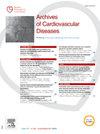高胆固醇血症和蛋白转化酶枯草杆菌素/酶9型可增强生物人工主动脉瓣的炎症和纤维钙化重构
IF 2.2
3区 医学
Q2 CARDIAC & CARDIOVASCULAR SYSTEMS
引用次数: 0
摘要
钙化性主动脉瓣狭窄是较为常见的瓣膜疾病,影响10%以上的患者。75岁。手术或经导管主动脉瓣置换术是唯一可行的治疗方法。生物假体瓣膜(BP)的使用越来越多,即使逐渐发展的结构性BP恶化(SVD)限制了它们的耐用性。最近的临床研究强调了循环脂质因子之间的关联,如蛋白转化酶枯草杆菌素/kexin 9型(PCSK9),脂蛋白(a)和低密度脂蛋白(LDL),和SVD。然而,其潜在机制尚不清楚。目的:研究高胆固醇血症和/或PCSK9在导致SVD的早期过程中的作用。方法将BP组织皮下植入10周龄野生型(WT)、PCSK9敲除型(KO)和PCSK9过表达型(PCSK9 OV)小鼠28 d。定性解剖病理学评分评估细胞密度、浸润和组织降解。通过免疫组化对浸润细胞进行表征,并通过大量rna测序鉴定调节的信号通路。用PCSK9和/或氧化ldl (ox-LDL)刺激小鼠腹腔巨噬细胞6小时。结果PCSK9 OV小鼠外植拳击孔的解剖病理学评分明显高于WT和KO,分别为7.0[4.1-8.4]、4.0[3.0-4.5]和2.8 [2.0-3.9];p = 0.008)。与WT和KO相比,PCSK9 OV小鼠中巨噬细胞和粒细胞的浸润量显著增加(P = 0.01和P = 0.002)。RNA-seq分析显示,与KO相比,PCSK9 OV小鼠的纤维钙化重塑信号通路丰富。巨噬细胞刺激突出了差异反应:ox-LDL激活促炎信号通路,而PCSK9促进促钙化细胞因子释放。结论高胆固醇血症和/或高PCSK9水平可通过粒细胞和巨噬细胞的浸润以及纤维钙化信号通路的激活,增强对BP组织的炎症反应。PCSK9促进促钙化细胞因子的激活,而ox-LDL则增加促炎症途径。本研究指出了高胆固醇血症和PCSK9在BP组织植入后早期的特定作用,对SVD的发生有潜在的指导意义。本文章由计算机程序翻译,如有差异,请以英文原文为准。
Hypercholesterolemia and proprotein convertase subtilisin/kexin type 9 potentiate inflammation and fibro-calcific remodeling in bioprosthetic aortic valve
Introduction
Calcific aortic valve stenosis is the more frequent valvular disease, affecting more than 10% of patients > 75 years old. Surgical or transcatheter aortic valve replacement is the only treatment available. There is an increased use of bioprosthetic valves (BP), even if the progressive development of structural BP deterioration (SVD) limits their durability. Recent clinical studies highlighted an association between circulating lipid factors, such as proprotein convertase subtilisin/kexin type 9 (PCSK9), Lipoprotein (a) and low-density-lipoprotein (LDL), and SVD. However, the underlying mechanisms remain unknown.
Objective
We aim at deciphering the role of hypercholesterolemia and/or PCSK9 on the early processes leading to SVD.
Method
Subcutaneous implantation of BP tissue was performed on 10-week-old wild type (WT), PCSK9 knock-out (KO) and PCSK9 overexpressing (PCSK9 OV) mice for 28 days. A qualitative anatomopathological score evaluating cell density, infiltration, and tissue degradation was developed. Infiltrated cells were characterized by IHC and modulated signaling pathways were identified by bulk RNA-sequencing. Mice peritoneal macrophages were stimulated for 6 hours with PCSK9 and/or oxidized-LDL (ox-LDL).
Results
The anatomopathological score was significantly higher in the explanted punches from PCSK9 OV mice as compared to WT and KO (7.0 [4.1–8.4] vs 4.0 [3.0–4.5] and 2.8 [2.0–3.9], respectively; P = 0.008). Macrophages and granulocytes were the more abundant infiltrated cell types with a significant increase of granulocytes in PCSK9 OV mice as compared to WT and KO (P = 0.01 and P = 0.002, respectively). RNA-seq analysis revealed an enrichment of fibro-calcific remodeling signaling pathways in PCSK9 OV mice compared to KO. Macrophages stimulation highlighted differential responses: ox-LDL activated pro-inflammatory signaling pathways whereas PCSK9 promoted pro-calcifying cytokines release.
Conclusion
Hypercholesterolemia and/or high PCSK9 levels potentiate the inflammatory response against the BP tissue, with an infiltration of granuloytes and macrophages, and an activation of fibro-calcific signaling pathways. PCSK9 promotes the activation of pro-calcifying cytokines whereas ox-LDL increases pro-inflammatory pathways. This study points out for a specific role of hypercholesterolemia and PCSK9 in the early phases post implantation of BP tissue, with potential implication in the development of SVD.
求助全文
通过发布文献求助,成功后即可免费获取论文全文。
去求助
来源期刊

Archives of Cardiovascular Diseases
医学-心血管系统
CiteScore
4.40
自引率
6.70%
发文量
87
审稿时长
34 days
期刊介绍:
The Journal publishes original peer-reviewed clinical and research articles, epidemiological studies, new methodological clinical approaches, review articles and editorials. Topics covered include coronary artery and valve diseases, interventional and pediatric cardiology, cardiovascular surgery, cardiomyopathy and heart failure, arrhythmias and stimulation, cardiovascular imaging, vascular medicine and hypertension, epidemiology and risk factors, and large multicenter studies. Archives of Cardiovascular Diseases also publishes abstracts of papers presented at the annual sessions of the Journées Européennes de la Société Française de Cardiologie and the guidelines edited by the French Society of Cardiology.
 求助内容:
求助内容: 应助结果提醒方式:
应助结果提醒方式:


